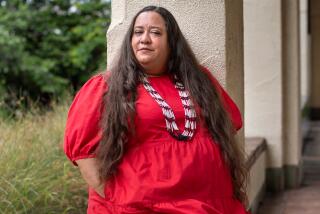Tragedy Brings Samoans Together : Race Relations: Slaying of girl may be the shock that spells an end to the long-standing isolation of Oceanside’s community of some 5,000.
- Share via
A wayward bullet and the death of a teen-age girl have snapped Oceanside’s large Samoan community out of half a century of isolation.
Most Samoans live close together in modest neighborhoods outside Camp Pendleton’s back gate, where they mainly have kept to themselves while elders sternly coped with a younger generation that eagerly adopted American ways.
But suddenly, the leaders of the city’s estimated 5,000 Samoans are striving to see their people enter the political and economic mainstream and struggling to heal the deep generational wounds among many Samoan families.
The demand for change was spurred by the Oct. 1 shooting death of 14-year-old Michele Tate, a popular black girl allegedly slain by a Samoan youth as she and friends left a restaurant.
“A bullet found a body and the leaders of the Samoan and black communities have to answer because of the outrage,” said Wayne Godinet, a Samoan and director of the local Boys and Girls Club. “It took that incident to pull us together.”
Two months after Tate’s death, Samoan leaders have strengthened relations with Oceanside’s black community, and met frequently to take stock of the Samoan community.
They’re creating a special 15-member Samoan council to include ministers, local Samoan chiefs, other leaders and youth representatives to set still-hazy political, economic and cultural goals.
“We used to live in a world of isolation, a cocoon,” said the Rev. Uatisone Afaese, the Samoan-born minister of the Seventh Day Adventist Church in Vista, which has 150 Samoan members.
That isolationism is beginning to end, perhaps ironically so.
The call for progress was spurred because police initially suspected that Tate was slain by violence between rival black and Samoan youth gangs, and ethnic leaders mobilized in fear of further gang bloodshed.
However, authorities later concluded the shooting wasn’t gang related at all, and now believe that Akeli S. Kelly, a 21-year-old Samoan, had fired a rifle at a personal enemy standing near Tate, and the poorly-aimed shot killed her instead. Kelly awaits trial for murder.
Relieved the shooting was not part of a gang war, Samoan leaders regard the incident as a tragedy they hope it will inspire a new era of progress.
They are starting from scratch, unsure even of their own numbers.
With 1990 Census figures not being released until next year, Samoans rely on guesswork to fix their Oceanside population.
Salefitu Siva of the Office of Samoan Affairs in San Diego puts the figure at between 4,000 and 5,000, giving Oceanside the largest Samoan community in San Diego County, which has about 10,000 Samoans.
The Pacific Islanders began arriving here through Camp Pendleton during World War II. Many of them had joined the Marine Corps during the war; others worked as support staff during the labor-needy war years.
Most Samoans belong to the Congregational Christian Church, but the older generation also clings to many native beliefs and rites. For example, there are Samoan chiefs in Oceanside, continuing the social hierarchy of the islands.
The chiefs, all-powerful back in the islands, have a mostly symbolic role here, but still influence the decisions of related Samoan families, even extended families and families from the chief’s old village in Samoa.
And it’s common to see older Samoans wearing sandals and a traditional skirt-like garment, called a lava lava.
Despite a strong culture and values, Godinet and other younger Samoan leaders bemoan a breakdown in many families.
As many younger Samoans see it, the first generation is structured and unyielding, demanding discipline and respect from their children, keeping problems to themselves, and distrusting the American drive for material rewards.
But newer generations trying to adapt to their new culture are seeking the hallmarks of American success--independence, activities away from the family, fashionable clothes, nice cars, and money.
Godinet observed that for Samoan youth, “there’s a mixed message. The same time they’re trying to adapt to Western culture, learning about individualism and capitalism, we’d go home and everything was family oriented.”
Parents often don’t understand the desire to stay out with friends rather than be with family; and when a Samoan youth earns money from a job, parents often expect the proceeds to be handed over to support the whole family.
“If mom and dad buy me a bike, they can say it’s mine, but it’s really for the whole family,” Godinet said.
He said many Samoan-born parents, frustrated by their children’s hunger for freedom and individuality, have often resorted to harsh discipline to maintain family order.
Painfully recalling his own upbringing, Godinet, the son of a career Marine, said, “some of the physical spankings and disciplining would be termed close to that fine line of physical abuse.”
Even some younger Samoans express concern that assimilation is taking youth too far from cherished values or an awareness of their roots.
George Molifua, a 42-year-old businessman and second generation Samoan, said “I remember my grandfather telling me legends (from) before there was a written language.”
“I want the children to know where they come from, who they are,” he said.
While young and old Samoan leaders want youth to respect and know of their heritage, some also acknowledge Samoan-born parents must try to accept certain cultural differences.
Faatamalii Falo, a mental health social worker with the Union of Pan Asian Communities in San Diego said, “Parents are trying hard to limit the involvement of their children. They think that out there, something’s going to happen. They’re scared for their children.”
Parental efforts to control the children often brings confrontation that leaves parents isolated and estranged from their children, who are confused by the cultural clash.
Falo said she tries to educate Samoan-born parents “not to give up their culture completely, but we need to meet our children born here halfway.”
During this time of introspection, Samoans leaders are talking about the need to end the stereotype that Samoan youths are big, aggressive and talented only in athletics.
There are about 550 Samoans among the 16,000 students in the Oceanside public schools, and it’s true many have distinguished themselves in sports.
“We’re known to much of the community as being great athletes,” said Kimo Marquardt, a Samoan and vice principal of El Camino High School. What distresses him is how many Samoans drop out of school, and the fact that “very few” Samoans who are graduated from high school go on to college.
Marquardt said, “the main challenge will be to keep the students in school and go on for higher education.” He believes greater academic successes largely depend Samoan parents, many of whom have failed to take an active role in their children’s education.
The young generation of Samoan leaders is also concerned about the poverty in their community, although even here there is a dichotomy. While many work hard, sometimes taking two low-paying jobs to make ends meet, others simply don’t seek material goods and prefer to live modestly.
At any rate, getting a fix on Samoan poverty is elusive, mainly because they quietly take care of themselves and few are seen homeless or begging.
“This is a very close-knit community that takes care of its own,” said Carol Baenziger, spokeswoman for the county Department of Social Services. “There are not many receiving public assistance.”
The coalition of leaders is determined to see Samoans break out of their cultural shell and solve some specific problems, including youthful drug use and gang membership.
Rev. Afaese said, “one of the greatest challenges of my own ministry is the youth. They are more and more moving toward drugs and gangs and away from the work ethic.”
Godinet said most Samoans don’t vote and have traditionally shied away from community events, whether political or social.
“We’re powerless when we talk to the city council or any politician because we don’t have a voting block,” said Godinet, who envisions a time when Samoans take their needs and ideas down to City Hall and feel more a part of the community’s cultural fabric.
Rev. Afaese remembers that when he moved here from the islands 15 years ago, “we tried to organize ourselves into some association, but nobody was interested.”
Although Alfaese, Godinet and others believe the time is right for involvement, they’re still cautious, not knowing for sure whether their call for activism in the wake of the Tate shooting will mobilize large numbers of Samoans.
Said Godinet: “Now we’ve identified our problems, we’re caught without funding or a voter base. If we continue like that, we’re fundamentally hopeless.”
More to Read
Sign up for Essential California
The most important California stories and recommendations in your inbox every morning.
You may occasionally receive promotional content from the Los Angeles Times.













